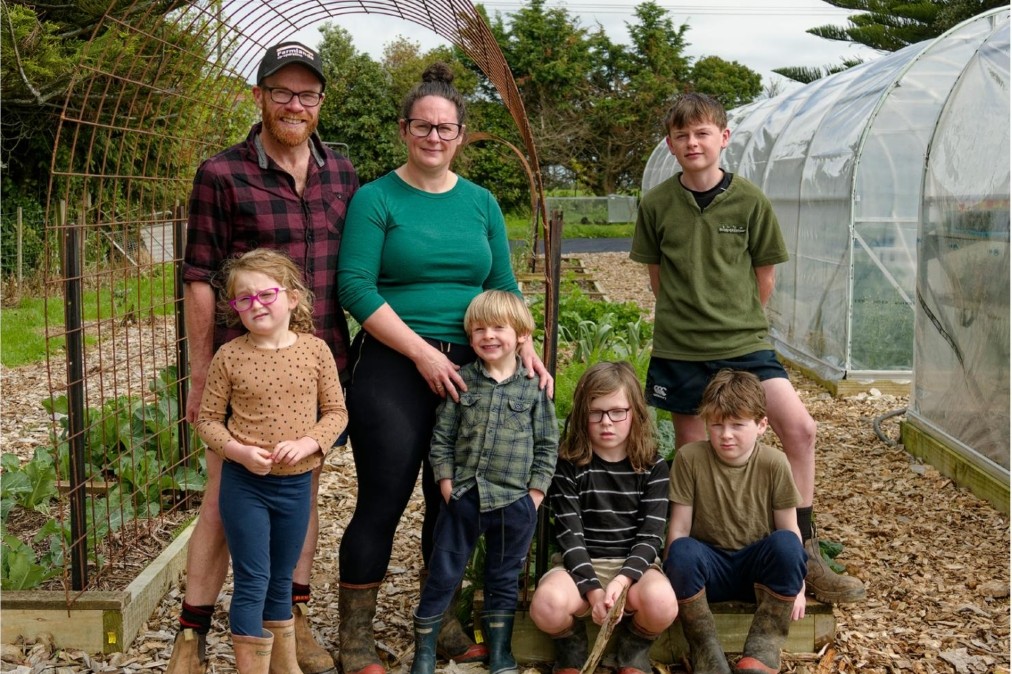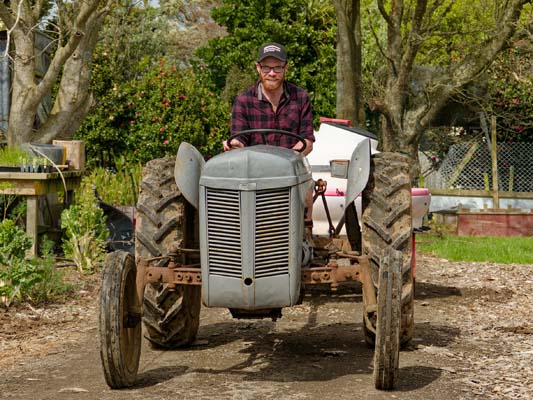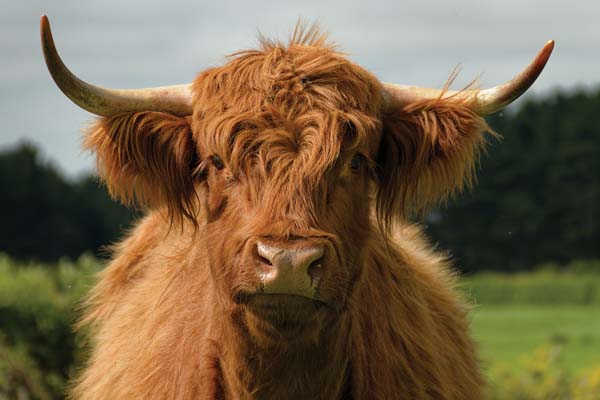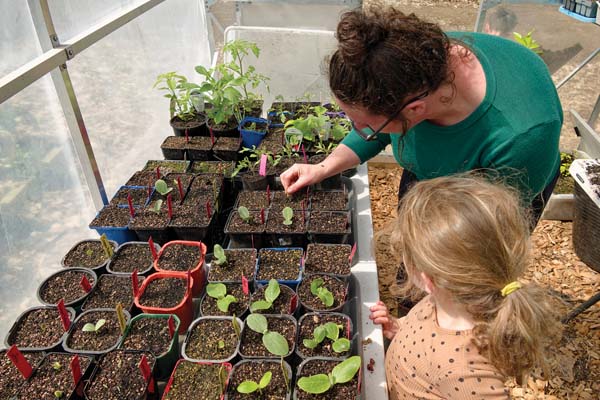Farming for the community
A south Taranaki couple met as small children, reconnected at Massey University, and are now producing for their community. Story and photos by Ross Nolly.

When Lance and Claire Mullin bought their first farm, the last thing they needed was to suffer a severe drought. But that setback, and the need to control their spending when purchasing that farm, set them towards something they’d always wanted to try, before necessity forced their hand.
The couple had always wanted to grow their own food and to be as self-sufficient in food as possible, and those financial trials prompted them to give it a go.
Now, they’re not only growing their own food, they’re planning to supply their community with CSA (Community Supported Agriculture) vege boxes from their surplus produce.
Community Supported Agriculture is a farming model where a local community supports local food producers. CSA subscribers pay a weekly fee to receive a weekly box of fresh, seasonal vegetables.
The couple own a 55-hectare farm at Pihama, coastal south Taranaki, and lease a 30ha runoff (82ha total effective).
Lance grew up on his parents’ farm and attended the local primary school where he and Claire first met, when he was five years old and Claire was three. After high school he attended Massey University to complete a Bachelor of Applied Science and Agriculture.
 “Claire and I met again at a get-together when our local Te Kiri Primary School closed. I was 20 and Claire was 18, and we discovered that we were both studying at Massey,” Lance says.
“Claire and I met again at a get-together when our local Te Kiri Primary School closed. I was 20 and Claire was 18, and we discovered that we were both studying at Massey,” Lance says.
Claire completed a Bachelor of Arts in social anthropology and a post-graduate diploma in teaching. She taught for two years before the arrival of their first child.
After university Lance spent two years as an assistant manager on a 90ha Kaponga farm milking 300 cows. The couple then spent a year dairy farming in Northern Ireland.
They’ve named their farm Ballymullin Farm in homage to the Irish tradition of using “Bally” meaning “place of” in the name of many towns and villages.
“We came home and managed this farm for mum and dad for a year, before deciding to do our own thing. We spent three years milking 230 cows on a leased Parihaka Pa farm at Pungarehu,” Lance says.
That period was a good introduction into running their own farm. Claire was teaching at Rahotu Primary School and helped out on the farm on weekends, and raised their calves.
They then moved to Ngaere, in central Taranaki, as 50-50 sharemilkers for two years before returning to the family farm as 50-50 sharemilkers. By then they had two children and another on the way, and decided this would be their last move.
They now have five children between the ages of five and 12, and the last 10 years have been incredibly busy. Two years later Lance’s parents told the couple there was potential for them to buy the farm. They’ve now owned it for six years.
“We have a huge amount of debt, but we’ve been able to achieve our goal of becoming farm owners with our own piece of dirt,” Lance says.
The couple milk 240-250 cows made up of 60% crossbred, 30% Friesian and 10% Jersey.
“A smaller herd allows you to know each cow by sight. Often, I don’t know them from their tag numbers; I know them by their back ends. We’ve never wanted a large herd. We’d milk 100 cows if it was profitable,” Lance says.
They’ve gradually been changing systems to fit around their life, rather than fitting their life around the farm. Lately, they’ve been discussing what they’d need to do to eliminate using a leased runoff and to milk 180-200 cows.
They use a 10-in-7 milking roster after AI has finished. It’s their way of taking a step towards their long-term goal of once a day (OAD) milking. The 10-in-7 regime works well because Claire now milks two days a week and Lance doesn’t have to be in the shed at all on those days.
Last year they milked their heifers OAD for the entire season, and they did amazingly well. This year they’ve come in as second calvers and are producing well. “We’re not sure when we’ll transition to OAD milking. We’ve done it in the past during droughts. But due to this year’s projected lower payout, we’ll put it on hold for a bit longer,” Lance says.
The farm’s three year milksolids average is 370kg per cow. The last two seasons have been particularly difficult, but during 2020/2021 they produced just over 390kg MS/cow, which is what they feel is appropriate for their system.
Their 27-year-old 30-bail rotary shed has ACR and automatic teat sprayers. It’s a good one-person shed giving them flexibility around their children and the family’s self-sufficiency goals.
“This is the first year that I haven’t milked during calving. I haven’t usually done many morning milkings because I’ve been kept so busy with the kids,” Claire says.
“I mostly milk by myself,” Lance says. “To simplify things, we only milk the colostrum cows in the morning, and in the afternoon we don’t have any heifers to milk, which amounts to 50 fewer cows to milk per day.”
Over the last few years they’ve done a great deal simplifying their system, and they continue making changes to make life easier. They’ve recently re-fenced the farm to even-up their paddock sizes so that when they fully transition to 10-in-7 milking they can utilise 24-hour grazing.
Effluent spreading has always been land-based and uses a travelling irrigator over an 18ha effluent platform. Due to limited storage, a Vortex Effluent Bladder will be installed in the upcoming months.
Historically, their farm has been a System Two operation, but this year it’s a System Two/Three.
During spring they operate a 38-day round and 20 days during the peak growing season. After Christmas they begin to stretch the round out again.
They make 70 bales of hay and 200 bales of silage and buy extra from Lance’s parents’ runoff if needed.
Even though the farm is mostly summer safe, 5ha of turnips are cropped as part of the farm’s regrassing programme. The turnips are fed out in mid-January and they aim to get about 60 days’ feed from the crop.
Lance’s parents have always fed PROLIQ and Lance and Claire continue the practice. They feed palm kernel, but this year they’ve moved to PKExtra 30 (a precision blend of 70% palm kernel and 30% molasses).
The cows are fed 2.5-3kg each per day from troughs at the cowshed. They’ve considered installing in-shed feeding, but it’s capital they don’t want to spend at the moment.
Lance is the farm’s AI technician and performs the AI on the platform during milking, eliminating the need for a drafting system.
“That’s when Claire starts doing afternoon milkings, which allows me to do the AI. When a cow requiring AI comes on to the platform, Claire keeps milking while I inseminate the cow before it backs off the platform,” Lance says.
“This eliminates the tasks of drafting cows and bringing them back in for AI, and hosing out the shed again. We’ve always done DIY AI, and it saves us a lot of money.”
Mating starts on October 18 with five weeks of AI followed by five weeks with Murray Grey or Red Devon bulls. Heifers mating using Jersey bulls begins on October 18.
They have been a CRV progeny testing farm since they bought their herd in 2009. They use reduced-priced semen from bulls that aren’t yet in the catalogue. CRV collects the heifers’ herd test data and Holstein Friesian New Zealand performs TOP and DNA tests on them.
“The bulls are selected from CRV’s top bulls and are genetically proven. Essentially, this is proving them in practice. Usually, within the next few years you see the bulls we’ve used being genetically top in their categories,” Lance says.
“The semen price varies from $4-$7 per straw compared to the usual $20 and it’s saved us a lot of money.”
They aim for an efficient 400kg cow with good longevity. Lance feels that they’re the type of cows that look after themselves and “just keep trucking along”.
They’ve always tried to breed for a low SCC. It sits about 180,000, but last season averaged 160,000.
Last year’s in-calf rate was 94%. The cows were fed well and consequently were in good condition and cycled very well. Lance feels the heifers being on OAD definitely helped fertility.
Last year was the first time they didn’t use any CIDRs. It worked so well, they’ve decided to do the same this year, also saving them money.
Calving begins on July 28 with a typical six week in-calf rate of 70%. The calves are left on the cows for 24 hours to ensure they get their gold colostrum. They keep about 45 (18%) replacements to make life easier during spring and cut grazing costs.
Claire raises the calves in a calf shed with five pens and wood chip bedding. She feeds them colostrum while it lasts before switching to milk powder. The new calves are fed warm colostrum for the first four days before transitioning to cold milk.
The calves are fed ad-lib from feeders filled each afternoon. This is another time-saving measure so Claire doesn’t need to feed the calves twice daily.
“We’ve dropped many tasks that we felt weren’t essential. This year we haven’t fed meal to the calves, and they’re doing really well on grass and hay,” Claire says.
“It was purely a financial decision. Research showed me that calves should do well if they’re well fed, on hay and water from day one, and put out on to grass as soon as possible. We’ll try it again next year. Hopefully it’s something we can carry on with. Those cost-saving measures soon add up in our small system,” Lance says.
The calves are weaned when Claire feels they look like they’re ready for it, using her ever-trusty “eye-ometer”. The calves stay on the farm until mid-January before going to Lance’s parents’ runoff for grazing. Fitting the farm around the family
Fitting the farm around the family
“One of our goals is for the farm to fit around our life. The farm has to be profitable for us to keep it, but it’s pointless for me to work 100 hours a week and never see Claire and the kids. You then begin asking yourself what you’re doing it for,” Lance says.
About three years ago they realised that because they were so busy, the business side of running the farm wasn’t their strongest aspect. So they contacted financial adviser Nick Bettington of OpenGate Finance.
They meet monthly and update their forecast budget and actuals. His input has proved very beneficial to them by coming up with financial goals, keeping them on track and forward-looking.
Through him they have a great relationship with their bank. The bank is kept informed on a monthly basis of any decisions they’re planning.
“We try to be quite conservative with our budgets and question everything we buy because you never really know what’s ahead. We’ve never been big spenders though,” Claire says.
Two years ago, after a couple of good payouts, Nick suggested they undertake infrastructure work to simplify the farm system while the payout was high. They straightened their races to improve cow flow, which has saved them 30-45 minutes a day sitting behind their cows.
“One of the great things about farm life is that we do it with the kids. On the weekends and over summer the iPads are put away and the kids are out with us, eeling, or swimming in the river. We often camp by the river during summer. It’s a free holiday. I milk in the morning and then enjoy the day with the kids,” Lance says.
Lance collects Ferguson tractors and implements, and is a member of the Taranaki Vintage Machinery Club and North Island coordinator for The Friends of Ferguson Heritage, a worldwide Ferguson club.
“I really enjoy getting the old machinery out, and the vege gardens are the same scale that the machinery was built for,” Lance joked.
Claire and Lance love collecting items that have a purpose. Claire has made many great op-shop scores, including a 1950s cream separator. Part of their sustainability mindset is using an old item that can do the job instead of buying new.
“I’ve got around 20 Fergie tractors and around 60 field implements for them. Some items are quite rare and go straight up on the shelf, but we like collecting stuff that we can use,” Lance says.
Self-sufficiency practices to save the farm
The financial implications caused by drought and purchasing their farm led the couple into self-sufficiency. It didn’t start out as a way to diversify their income; they simply needed to save money.
“We were really scared that we’d only just reached our goal of buying our farm and were now about to lose it. We decided to show the bank that we deserved to be here. We just wanted to survive. To keep the farm, we had to live very frugally,” Claire says.
They began growing vegetables in two raised beds near the house and dug up the lawn surrounding them for in-ground gardens. They quickly realised they really loved growing food, and that their garden wasn’t large enough to feed their family. They now have a 2ha space designated to become food production gardens; to raise sheep and pigs for meat, and chickens for eggs.
“We were very hard on our personal spending during that first year and drastically cut our drawings. Nick told us that he’d never seen anyone make such a dramatic change in one season,” Lance says.
“In the past we’d often discussed growing our food, but we thought it was too difficult, too expensive to start, or we were just too busy. So why not wait until you’re flat out busy and have five kids!”
Necessity may have forced them to embark on self-sufficiency, but they quickly learned it was the lifestyle they’d always wanted, and they wished they’d started sooner.
“You don’t need a lot of money to do it; you just dig up the ground and put some plants in. It’s great for the kids because they’re out there learning things that we never learnt as kids,” Claire says.
During summer a large proportion of the family’s meals are 100% home-grown. Their meat comes from their own pigs, sheep and cattle, and Claire harvests the greens and potatoes. “We’ve just built a big greenhouse that was paid for by selling weaner pigs and potatoes. It didn’t come from drawings,” Claire says.
This year, to cut costs, Claire has decided to grow everything from seed and to harvest her own seed for next year’s plantings. They’ve recently planted 400 strawberry plants grown from the runners of plants they bought two years ago. With the nation experiencing a shortage of strawberries, they’re hoping for a bumper summer crop. Last year they sold out their potato crop, but are now deciphering how to strike a balance between having enough produce for themselves, as well as a surplus to sell. No chemicals are used on the potatoes. One of Lance’s Ferguson implements is a mechanical weeder that would have been used in the 1940s and 1950s, and is ideal for weeding the potatoes. They try to preserve as much food as possible; especially staples like fruit, veges and potatoes.
“Tomatoes are important to us. Last year was an awful tomato season and we were grateful to have enough to eat, let alone preserve. They’re my big focus this year. I want to try and preserve them as diced tomatoes, tomato paste and passata,” Claire says. “I use a pressure canner to preserve potatoes. We’ve made tons of them and they’re great. You only need to open a jar, put them in the oven, and your side for tea is done.”
Lance gets a massive kick growing potatoes; it’s something he’d always wanted to try. When he ordered this year’s seed potatoes the salesperson immediately said “Are you sure you want a tonne?”
Lance and Claire love the fact that growing their own food is something they do together, and they derive great pleasure making a 100% home-grown meal. They feel it’s a simple and often overlooked pleasure.
“I love being in the garden with Claire and the kids doing something that is for all of us. It’s addictive once you get started,” Lance says.
“When it’s been raining the kids go out and use the tarp covering the soil on the beds as a big slip and slide. It’s cool seeing them come home from school and rush out there. They often help me plant seedlings too,” Claire says.
Simplifying the farm has helped make time for the self-sufficiency aspect of their life. They’d like to continue simplifying the dairy system to OAD milking and 24-hour grazing. “We don’t want to get so big that we don’t enjoy it. Our short-term goal is to have the vege garden cover our drawings from the farm business. I think we’ll get close to that this year,” Claire says.
As well as using Facebook and Instagram, the Mullins have recently started a YouTube channel to show their food journey to a worldwide audience. They want to share their reality on their social media, not an idyll specifically designed to look great for the camera.
“We’re not perfect. We still get takeaways every now and then. Some people get into this lifestyle and shun anything that’s not seen as ‘only home grown’. Whereas we try to stay balanced,” Claire says.
Claire’s advice to others contemplating leaping into their own great unknown of growing their own food is; “All the advice tells you to start small. But I don’t agree, just jump in and go for it.” “It’s hard work, and we often get overwhelmed by what’s going on. But you remind yourself why you’re doing it and it makes it all worthwhile. You’re prepared to put in the extra work because you love it and it doesn’t feel like a job.”
KEY FACTS:
- Owners; Lance and Claire Mullin
- Location: Pihama (Taranaki)
- Area: 55 hectare and 30ha leased runoff (82ha total effective)
- System Two/Three farm
- Cowshed: 27-year-old 30-bale rotary has ACR and automatic teat sprayers
- Effluent system: Land-based, utilising a travelling irrigator. 18ha effluent platform. A Vortex Effluent Bladder will be installed in upcoming months
- Cows: 240-250 (60% crossbred, 30% Friesian and 10% Jersey)
- Production: Three year milk solids average is 370kg MS per cow. 2020/2021 season was just over 390kg MS per cow
- Supplements: 70 bales of hay and 200 bales of silage and buy extra from Lance’s parent’s runoff if needed PKExtra 30 (a precision blend of 70% palm kernel and 30% molasses). The cows are fed 2.5-3kg each per day from troughs at the cowshed
- Financials: FWE (kg MS) for the last three seasons were:
- $3.27, $3.19, and $4.42/kg MS (up due to large increase in costs) respectively. This year they are budgeting on $4.09/kg MS
- Their operating return on assets for the 22/23 season was 8.2%.





